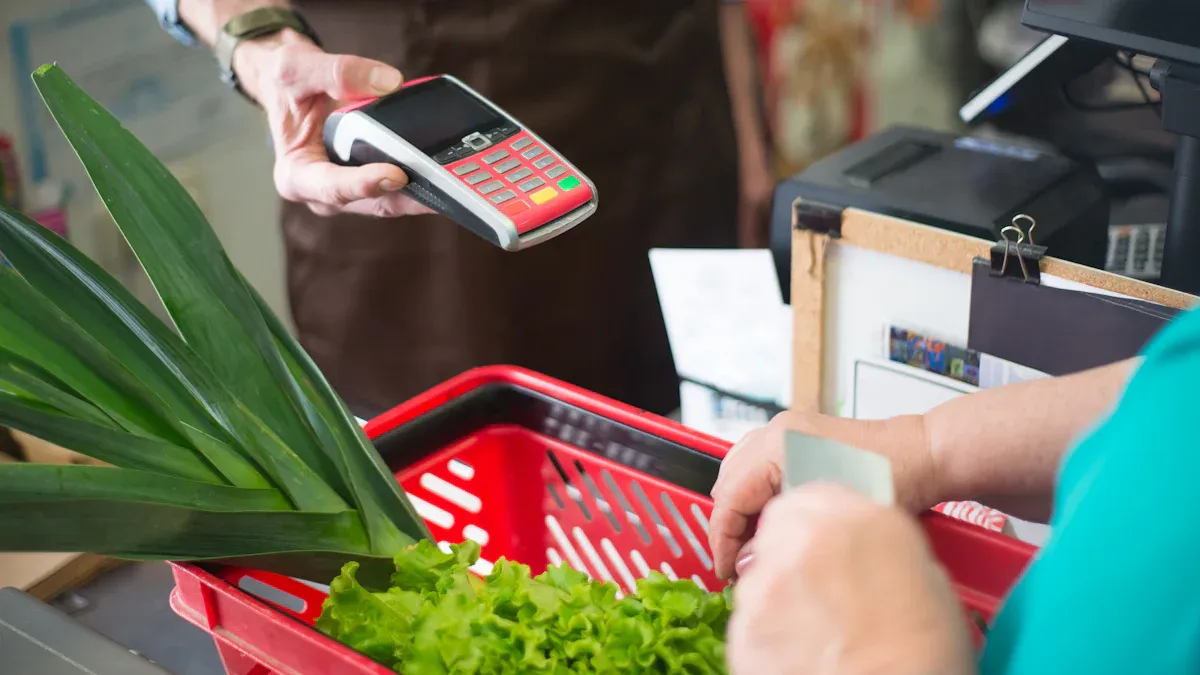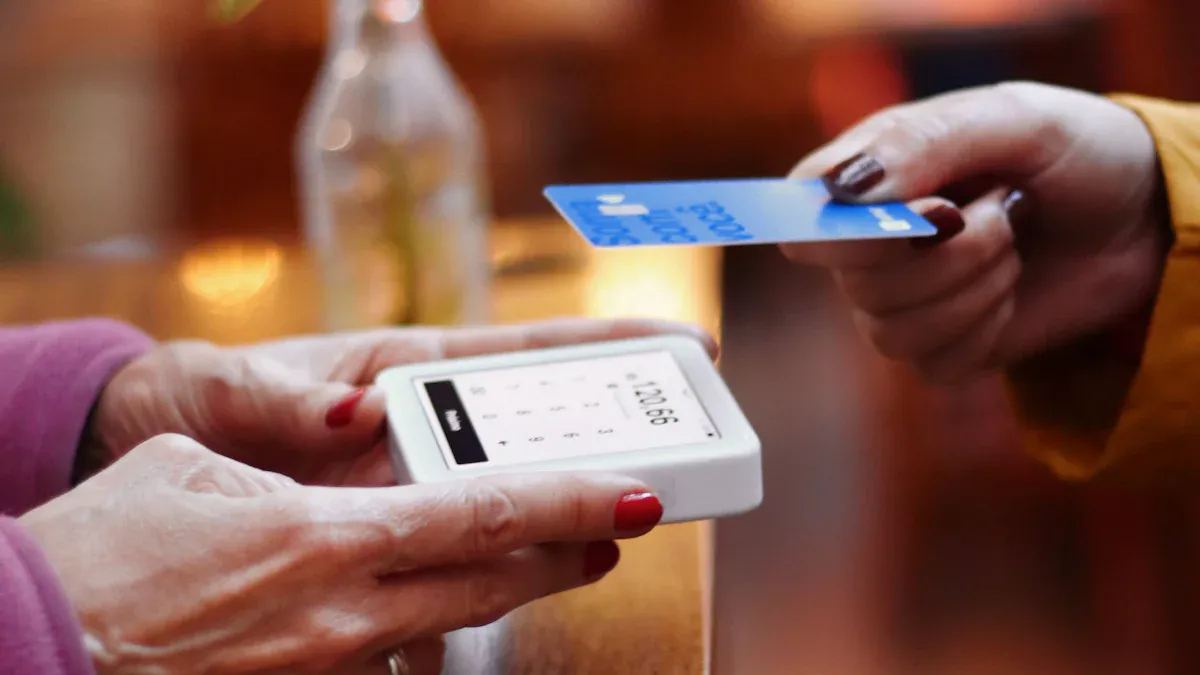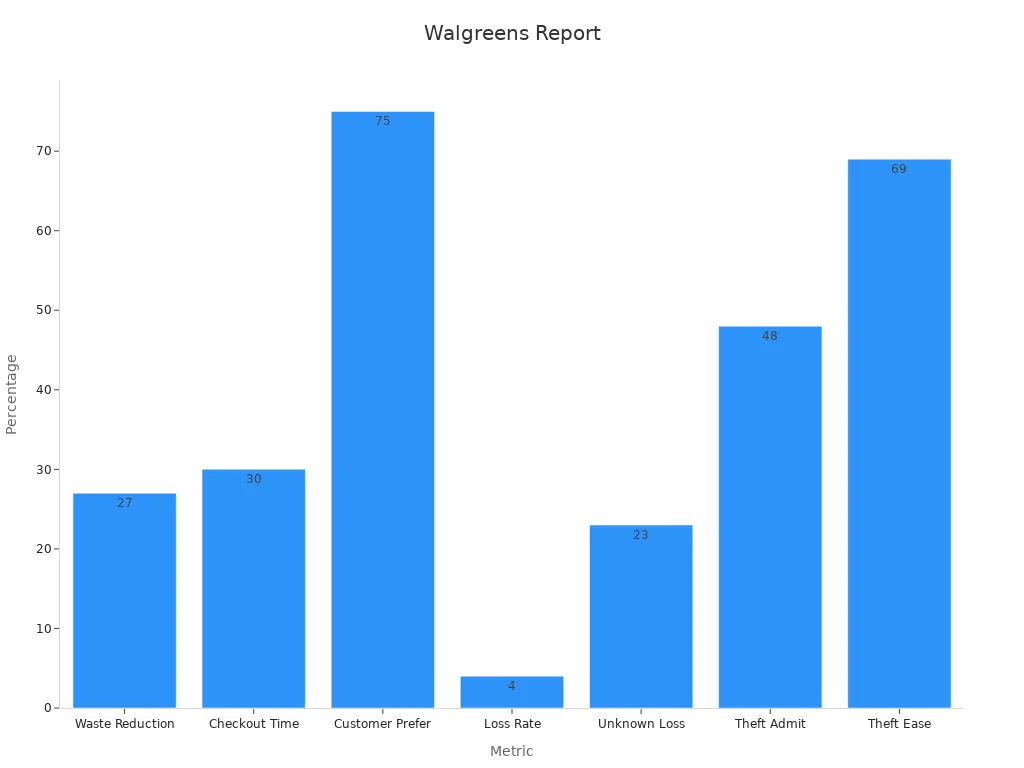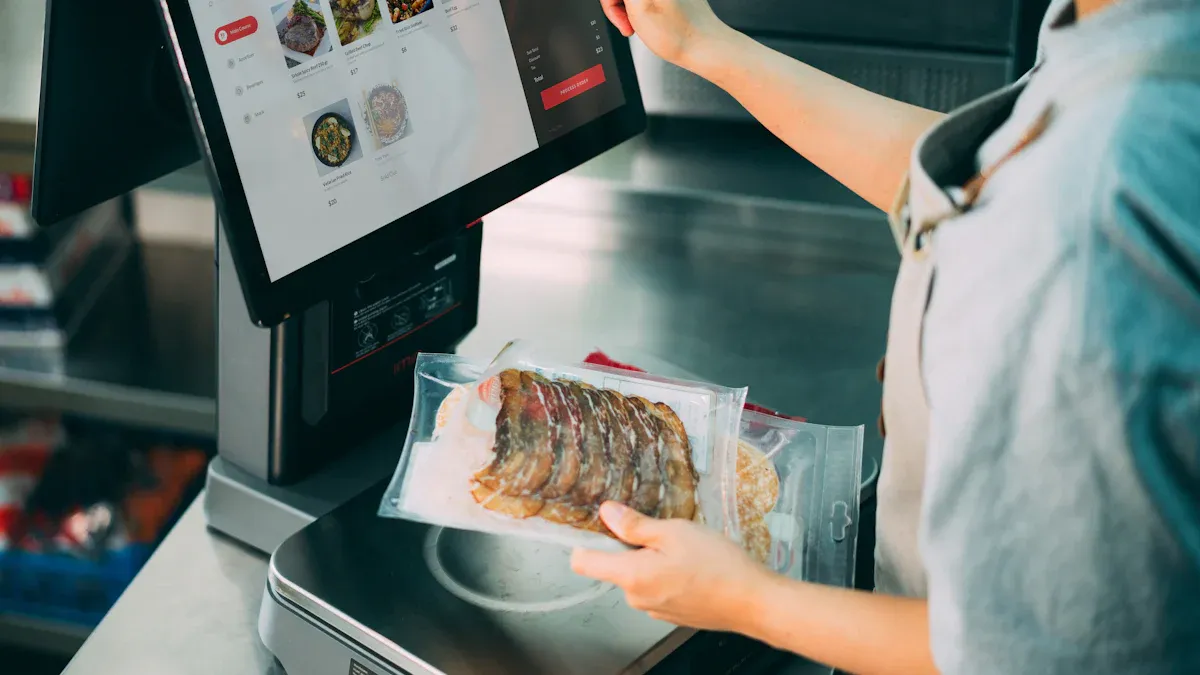Walgreens Self-Checkout Systems and their impact on the future of retail convenience

Walgreens self-checkout changes how you shop. You can avoid long lines and finish your checkout faster. Many people prefer self-checkout systems because they offer speed, flexibility, and mobile options. In fact, 66% of U.S. shoppers like to use self-checkout, and 86% avoid stores with long lines.
Benefit Category | Numerical Evidence |
|---|---|
Customer Preference | 66% of U.S. shoppers prefer self-checkout |
Mobile Checkout Convenience | 86% of shoppers avoid stores with long lines |
You see more stores using self-checkout systems as technology grows. Walgreens self-checkout gives you more control, but it also brings new questions about security and support.
Key Takeaways
Walgreens self-checkout lets you shop faster by skipping long lines and scanning items yourself, saving you time and giving you more control.
You can pay in many ways at self-checkout, including credit cards, digital wallets, and Buy Now, Pay Later options, making checkout easy and contactless.
The Walgreens app connects with self-checkout, letting you scan and pay from your phone for an even quicker, smoother shopping experience.
Advanced AI technology helps Walgreens prevent theft and errors during self-checkout, keeping your shopping safe and efficient.
Walgreens balances technology with staff support to help customers who need assistance and to improve the overall shopping experience.
Impact on Convenience
Faster Shopping
You want to get in and out of the store quickly. Walgreens self-checkout makes this possible. When you use self-checkout systems, you skip long lines and finish your shopping faster. Express lanes and digital kiosks help you move through the store with ease. You can scan your items, bag them your way, and check prices as you go. This process saves time, especially during busy hours.
Self-checkout saves time by cutting down wait times.
You gain more control by bagging items your way.
You can check prices as you shop.
Self-checkout kiosks accept many payment methods, including digital wallets and tap-to-pay.
Walgreens keeps staff nearby to help if you need it.
Mobile integration adds even more speed. You can use the Walgreens app to scan items as you shop. This grab-and-go feature lets you pay right from your phone. You do not have to wait at the register. The app also connects to loyalty programs, so you get discounts and rewards instantly. Personalized offers powered by AI have increased basket size for enrolled customers by 18%. This shows how technology can make your shopping trip smoother and more rewarding.
Tip: If you want to save even more time, try using the mobile scan-and-go feature next time you visit Walgreens.
Self-checkout systems are not just a trend. They are becoming the new normal. About 66% of U.S. shoppers now prefer self-checkout over traditional lanes. Walgreens self-checkout helps you shop on your own terms, making your experience less stressful and more convenient.
Flexible Payment Options
Walgreens self-checkout gives you many ways to pay. You do not need to carry cash. The systems accept credit cards, debit cards, digital wallets, and tap-to-pay. Some locations even offer Buy Now, Pay Later (BNPL) services. This means you can spread out your payments if you need to. A recent survey found that 39% of U.S. adults have used BNPL, with higher use among millennials and Gen Z. These groups are also more likely to use self-checkout.
Self-checkout systems accept many payment methods.
You can use digital wallets or tap-to-pay for contactless convenience.
BNPL options help you manage your budget.
Flexible payments make shopping easier for everyone.
Contactless convenience is important today. Self-checkout reduces the need to handle cash, which improves hygiene. You can pay quickly and safely. If you have questions or need help, Walgreens staff are always nearby. This balance between technology and human support makes shopping easier.
Walgreens self-checkout systems also connect with loyalty programs. You can scan QR codes to redeem discounts or earn points. This makes your shopping trip more rewarding. The combination of flexible payment options and digital rewards shows how Walgreens is leading the way in customer convenience.
Walgreens Self-Checkout Technology

How It Works
When you walk into a Walgreens store, you see dedicated stands for self-checkout. These stands have large touchscreens and easy-to-read instructions. You scan each item, bag your purchases, and choose your payment method. The self-checkout technology guides you step by step, so you do not feel lost. You can finish your checkout quickly, even if you have never used self-checkout systems before. Walgreens self-checkout stands use bright displays and clear prompts to help you avoid mistakes. Staff members stay close by to answer questions or help with any issues.
Tip: If you want a smoother experience, scan one item at a time and watch the screen for helpful tips.
Mobile and App Integration
Walgreens self-checkout connects with the Walgreens app on your phone. You can scan items as you shop, add them to your cart, and pay right from your device. This self-checkout technology lets you skip the kiosk if you want. The app also links to your loyalty account, so you earn rewards and get special offers. You can use digital wallets or tap-to-pay for fast, contactless checkout. This mobile integration makes self-checkout systems even more flexible and convenient.
AI and Security
Walgreens uses advanced AI in its self-checkout systems to keep your shopping safe and efficient. The AI watches for over 30 common loss patterns at checkout, such as missed scans or product switching. It can spot both honest mistakes and intentional theft in real time. This helps Walgreens reduce shrinkage, which costs the retail industry over $100 billion each year. AI also improves operational efficiency by catching errors like produce mix-ups or items left in baskets. A Forrester study found that grocery retailers using AI for self-checkout can see over 300% return on investment and break even in less than six months. Walgreens self-checkout technology uses these tools to protect your purchases and make checkout faster for everyone.
Benefits and Challenges
Customer Experience
When you use Walgreens self-checkout, you gain more control over your shopping trip. You can scan and bag items at your own pace. Many customers like this autonomy. In fact, 75% of shoppers prefer self-service options. Self-checkout also helps you keep your purchases private, especially for sensitive items. You spend less time waiting in line, as self-checkout reduces checkout times by up to 30%. However, some people face challenges. If you have limited mobility or trouble with technology, self-checkout systems may feel less friendly. Walgreens tries to help by keeping staff nearby and using hybrid models that mix self-service with personal assistance.
Aspect | Evidence / Figures |
|---|---|
Waste Reduction | Algorithmic monitoring reduced waste rates by 27%. |
Checkout Time Reduction | Self-checkout reduces checkout times by up to 30%. |
Customer Preference | 75% of customers prefer self-service options, increasing autonomy. |
Privacy | Self-checkout enhances privacy for sensitive purchases. |
Theft and Loss Rates | Self-checkout loss rate is 4%; 23% of unknown store losses come from self-checkout. |
Theft Perception | 48% of users admit to stealing; 69% believe self-checkout makes theft easier. |
Technical Issues | Common glitches include payment failures and kiosk freezes, requiring regular maintenance. |
Accessibility Challenges | Issues for customers with limited mobility, vision problems, or low tech familiarity. |
Staff Assistance Model | Hybrid models with staff assistance help mitigate challenges, improve customer service, and reduce theft. |
Monitoring Metrics | Usability improvements, efficiency metrics, communication enhancements, smart incident reporting, and assistance flags are used to track and improve system performance. |

Business Efficiency
Walgreens self-checkout helps the company save money and work more efficiently. Self-checkout systems can cut labor costs by up to 40%. This means Walgreens can use staff for other important tasks. You might notice more personalized offers and dynamic pricing, which can increase the value of your shopping basket. Walgreens also uses data from self-checkout to improve promotions and store layouts. However, some studies show that self-checkout may make you feel less valued, which can affect your loyalty to the store. Walgreens tries to balance these savings by offering rewards and making sure you see the benefits of using self-checkout.
Self-checkout reduces labor costs and increases operational savings.
Data from self-checkout helps Walgreens improve pricing and promotions.
Some customers feel less rewarded, so Walgreens adds loyalty perks and savings.
Addressing Theft and Issues
Self-checkout brings new challenges, especially with theft and technical problems. About 4% of self-checkout transactions result in losses, and 23% of unknown store losses come from self-checkout. Walgreens uses AI cameras and smart monitoring to spot theft and mistakes in real time. In some stores, staff retrieve products for you to prevent theft. Walgreens also tests new store layouts, like in Chicago, where you can only self-shop in certain aisles. These changes help reduce shrinkage but can cause frustration if you have to wait longer or cannot access products easily. Technical issues, such as payment failures or kiosk freezes, sometimes slow down your checkout. Walgreens responds with regular maintenance and by keeping staff ready to help. The company continues to adjust its approach, using both technology and human support to make self-checkout safer and smoother for you.
Note: Walgreens' CFO recently said that theft rates may not be as high as first thought, and losses have started to go down. This shows that new security steps and technology are making a difference.
Future of Retail Convenience

Industry Trends
You see self-checkout systems changing how you shop everywhere. Retailers around the world invest in new retail technology to make your experience faster and easier. The global self-checkout market is growing quickly. North America leads, but Asia-Pacific grows even faster because more people use digital payments and shop in cities. You notice more autonomous retail stores using smart carts, AI, and contactless payments. These stores let you scan items, pay with your phone, and leave without waiting in line.
AI and machine learning help stores recognize products and stop fraud.
Contactless and biometric payments make shopping safer and faster.
Smart carts and mobile apps let you finish your shopping with less effort.
Labor shortages push stores to use more self-checkout and automation.
Over 80% of U.S. retailers plan to add self-checkout in the next two years.
More than 70% of Americans say they like self-checkout for speed and control.
Year | Global Self-Checkout Market Size (USD) | CAGR |
|---|---|---|
2024 | ||
2032 | 12.2 billion | 13.4% |
You see autonomous retail stores in grocery, pharmacy, and convenience stores. These stores use AI, computer vision, and mobile integration to improve your shopping trip. The future of shopping will bring even more self-checkout options and smarter stores.
Walgreens’ Strategy
Walgreens uses self-checkout to give you more control and speed. The company invests in AI-powered monitoring to keep your shopping safe. Walgreens works with security experts and law enforcement to stop theft and protect you. The company uses data from self-checkout to learn what you like and improve your experience. Walgreens also tests new layouts and hybrid models, mixing self-checkout with staff help.
You notice Walgreens follows the same trends as other autonomous retail stores. The company uses advanced retail technology to fight theft and make shopping easier. Walgreens connects self-checkout with its app, loyalty programs, and digital payments. This approach helps you shop faster and get rewards. Walgreens’ strategy shows how the future of shopping will focus on convenience, safety, and personalization.
The future of retail convenience means you will see more autonomous retail stores, smarter self-checkout systems, and shopping trips that fit your needs. You will expect faster service, more payment choices, and stores that use technology to make your life easier.
Walgreens self-checkout changes how you shop and shapes the future of retail convenience. You see faster trips, more control, and new ways to pay. Self-checkout brings both benefits and challenges.
Some users admit to stealing, and shoplifting has increased by 93% since 2019.
Retailers like Target saw faster self-checkout times and higher satisfaction by limiting items.
Experts say self-checkout saves money and time but needs supervision.
You play a key role in this shift. Think about your own self-checkout experiences and how technology changes your shopping habits.
FAQ
How do you use Walgreens self-checkout?
You scan each item at the kiosk, bag your purchases, and choose your payment method. The screen gives you step-by-step instructions. Staff stay nearby if you need help.
Can you use the Walgreens app for self-checkout?
Yes, you can use the Walgreens app to scan items as you shop. You pay directly from your phone. This feature lets you skip the kiosk and finish faster.
What payment methods does Walgreens self-checkout accept?
You can pay with credit cards, debit cards, digital wallets, and tap-to-pay. Some stores also offer Buy Now, Pay Later options. You do not need cash.
Tip: Digital wallets like Apple Pay and Google Pay work for contactless checkout.
What should you do if you have trouble with self-checkout?
If you have a problem, ask a Walgreens staff member for help. Staff can fix technical issues or answer questions. You can also use the hybrid checkout lane for extra support.
See Also
Understanding The Benefits And Issues Of Walgreens Self-Checkout
Upcoming Changes To Walmart Self-Checkout Access In 2025
How Self-Checkout Technology Has Transformed Over Time
Common Problems Encountered With Walmart Self-Checkout Systems
How Cloudpick Checkout Computers Improve Efficiency And Customer Experience
